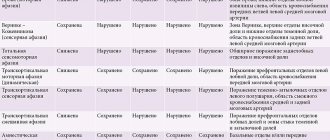There is a certain category of people who see something different in ordinary objects, for example, instead of a cloud in the sky, they see an animal, in a small tree on the side of the road they are able to recognize a person, and the foam on the coffee suddenly transforms into a grimace.
This visual illusory effect in medical practice is called pareidolia (pareidolic effect, pareidolia) - an ordinary object or its details are perceived differently by a person, creating a new image.
Both ordinary people with a well-developed imagination and psychologically unhealthy individuals, especially during periods of acute psychosis, have the ability to see such mirages. At the same time, the second category perceives illusions more realistically, and their duration can vary from a millisecond to several minutes.
Theory of the phenomenon
Today it is difficult to say where the theory of pareidolic illusion came from; all that is known for sure is that the word comes from the Greek language and literally means “near (near) the image.” In the scientific field, this phenomenon is also called the sensory illusion of addition.
The reasons for the effect have not yet been precisely studied, however, there are the most common theories:
- the need to see clear images
in objects for survival, which came to modern man in the course of evolution; - the easily suggestible nature of people who believe in God
or supernatural phenomena; - wild imagination, characteristic of creative people
who have developed pareidolia in the course of their professional activities: artists, designers and others; - mental and neurological abnormalities
: schizophrenia, severe stress, oneiric clouding of consciousness, etc.
The photo shows the most famous pareidolia - a face on the surface of the moon
One of the most common versions of the appearance of this phenomenon in a healthy person is evolutionary development and the desire to survive in ancient conditions, when it was necessary to distinguish between an enemy or an ally in the dark and at a long distance.
Homo Sapiens learned to clearly see the face of a person walking towards him even in pitch darkness, and also to distinguish a wild animal from a harmless one in the depths of a dark forest. Modern man, as unnecessary, has lost this ability, but for some it remains at an instinctive level.
A person transfers his phenomenon in the form of pareidolia to surrounding objects, in which he clearly sees various images, living beings, faces of famous people, etc.
Pareidolic illusion
A type of illusion (the so-called “sensory augmentation illusion”) consists in the formation of illusory images, the basis of which are the details of a real object. Thus, a vague and unintelligible visual image is perceived as something distinct and definite - for example, figures of people and animals in the clouds, the image of a person on the surface of the moon, “hidden messages” heard when reversing audio recordings, shadows formed by leaves or complexes of surrounding things under certain lighting (sometimes at a certain angle).
In general, this is called apophenia . This term refers to the experience of being able to see structure or relationships in random or meaningless data.
The word illusion comes from the Latin word illusio, which means delusion or deception. The explanatory dictionary defines this word as a distorted perception of a really existing object or phenomenon, allowing for ambiguous interpretation.
There is a whole section on our website containing a general description of illusions, thanks to which a person may get the impression that he has encountered some unexplained phenomenon. Such distortions of perception can occur both in mental disorders and in healthy people. They can be caused both by the physiological characteristics of the organs of perception and by special states of consciousness caused by psychological shocks or exposure to chemical substances.
In this article we will consider in detail the illusions of “expectation” that arise under the influence of pronounced mood swings or in connection with the affect of fear and anxiety, the result of which can be “an encounter with the unknown.” In general terms, this type of illusion is known as “ pareidolic illusion ” - this is a type of visual illusion that consists in the formation of illusory images, the basis of which are the details of a real object. Thus, a vague and unintelligible visual image is perceived as something distinct and definite (for example, figures of people and animals in the clouds, the image of a person’s face on the surface of Mars, “hidden messages” heard when reversing audio recordings).
Every person can tell at least one story about how he was frightened at night by some silhouette sitting on a chair or a ghost standing in the corridor. To illustrate, here are a few examples of such stories:
“I couldn’t fall asleep for a long time, lying on the bed in my room. The room was dimly lit by the bluish light of the clock dial and the rare light of the headlights of cars passing by the window. Already falling asleep, I noticed the black silhouette of an old man in a dark corner of the room. He sat on a chair with his head tilted to the side. Goosebumps ran across my skin. I began to blink frequently and even rubbed my eyes with my hands, trying to remove the obsession, but I saw it again as soon as I looked into the far corner. Now there was no need to look closely. I saw him so clearly that I seemed to see not only his wrinkled face, but also his gaze piercing me. I hid my head under the blanket and tried to distract myself and fall asleep, but sleep did not come. I wanted to read a prayer, but the words were constantly confused in my head and did not want to form into correct sentences. Then I decided to count. Having counted to three hundred, I lost my way, but felt that I had calmed down enough and decided to look out of my hiding place. The first thing I saw was the old man’s gaze. A new wave of horror washed over me. I was ready to scream and run out of the room, but then a car drove past the window. Before my eyes, instead of the old man, the light snatched a blanket lying in a lump on the chair.”
“I got up at night to drink water. I'm walking sleepily along the corridor and suddenly I see a white ghost hanging at full height in front of me. I jumped to the side in surprise. From such a rush of adrenaline, I finally woke up, but the ghost did not go away and continued to float in the air. In the next seconds, suppressing the urge to run back and hide under the blanket, I flicked the switch and saw my sister’s beige coat hanging on a hanger in front of me. In the morning, through laughter, she said that she hung it up so as not to wake up the whole house in the morning by slamming the closet door.”
Most often, such stories are told by children, but sometimes this can happen to an adult.
“My husband and I were very young then. Before going to bed, for some reason the conversation turned to devils. My husband convinced me that it was women's tales. They argued and argued and went to bed. I’ve already started to doze off, I feel Kolya pushing me. I open my eyes, and he’s so scared to me - look at the devil! I look and don’t see anyone where he is pointing. He still won’t calm down - there, he says, are the horns, the tail. I took a closer look - yes, it’s true, damn it! I saw him, then. I felt terrified, I was shaking, and out of fear I would jump up as soon as I turned on the light. I look: a pale husband is sitting on the bed, and by the stove it’s not a devil at all, but a bucket and a rag folded up so bizarrely that they look like a silhouette of a devil in the dark. If I turn off the light, damn it, but when I turn it on, it’s a rag with a bucket.”
The objects of such stories can be quite ordinary creatures, for example: a man, an old man, an old woman, a dog, a cat, etc., who evoke a feeling of fear only because they suddenly find themselves in a closed room that seems protected to a person. Sometimes it is precisely because of such sudden appearances that they are called not just, for example, “woman”, but “witch” (for children “Baba Yaga”).
Most of these cases are mystical creatures: devils, aliens, ghosts, etc. Their sudden appearance in a closed room does not cause fear due to the specificity of ideas about them. Here there is a fear that the creature may, for example, attack, or that its appearance promises some kind of trouble in life.
Often we do not notice such illusions. We can go to bed every night and see the same curtain, but in order to notice a ghost in it, we need a certain attitude, a certain psychological readiness for such a “meeting.”
This is well illustrated by the following experiment: Here is a blot. What do you see on it?
With a good imagination, you get a lot of different images. As a rule, they are objects that are familiar to you, and, first of all, that you are currently not indifferent to. You examined this blot in detail, found at least one image on it, and now every time you look at this blot, you will notice it first of all.
Now let's set the image: a bald man with a big nose and round eyes. Take another look at the blot. Did you find him? If not, then select it:
And now?
Now, looking at the picture, you will definitely distinguish this group of random spots from the general mass, even if you didn’t notice it before.
In addition to all the images on the blot, they found: Mickey Mouse, a horse’s head, a devil, and even an alien. Even if you didn’t find them before, now your brain will highlight them. Here they are:
Often psychological preparation for finding an image is implicit.
For example, if you listen to or start humming the song of a baby mammoth from the cartoon “Mom for a Baby Mammoth,” then the mammoth can easily be found on the blot. We will not indicate it, because, as it turned out, everyone finds their own mammoth and there are at least three of them in the picture.
The same effect can be observed when looking at photographs of trees and bushes.
Application in practice When a person feels anxiety and fear, but cannot understand its reasons, a method based on the described illusion can help to realize them. It is often used in their practice by healers who “pour out” fear with candle wax.
The result of “Pouring Fear” with wax.
The same method is also used by certified psychologists who study personality traits. It is known as the Rorschach Test or Rorschach Blots [2]. Each figure depicted on paper serves as a stimulus for free association - the subject must name any words, images or ideas that arise in his mind. The test is based on the assumption that what an individual “sees” in a blot is determined by the characteristics of his own personality in a broad sense, or by what he is focused on at the time of the test.
Auditory illusions
Almost everyone is familiar with the effect when, while bathing in the shower, through the noise of the water we hear a bell or a calling voice, and when we turn off the water, the sound disappears.
Here we see the same illusion described above, but for hearing. We hear words, melodies or other sounds expected in this situation among the white noise [4] (in this case, the sounds of water).
Similar techniques (listening to the sound of water, a TV or radio not tuned to the broadcast wave, inverted sound recording) are often used to contact ghosts, aliens and other mystical entities. In a state of anticipation of such contact, in the same noise you can hear names, words, and sometimes entire phrases of different content.
Conclusion
Illusions are very common in our lives. Sometimes they help us solve problems, sometimes they distract us. Everyone wants to face the unknown, and some are even willing, consciously or not, to deceive themselves. And those who want to encounter a truly unexplained case sometimes have to look at the world with different eyes. In order to find out whether it is really an illusion or a phenomenon in front of you, sometimes it is enough to turn on the light or get distracted a little. And perhaps it will turn out to be something unexplained.
What does it look and feel like?
If we are talking about pareidolia as a mental illness, then this phenomenon requires professional treatment, and also has several characteristic symptoms. Pareidolic illusions have the following manifestations:
- visual and auditory hallucinations;
- surrounding objects or patterns on them take on different forms;
- a person suffers from apathy and lethargy;
- the person exhibits severe causeless aggression;
- irritability and inability to concentrate on simple things.
In some cases, the patient becomes angry at inanimate objects, is frightened of them, or carefully examines them, tries to touch them, and can also conduct a dialogue with them.
Some psychiatrists also classify as symptoms of pareidolia such human abilities as the ability to see ghosts, UFOs, and fictional characters, such as brownies.
Thus, people who have suffered the death of a loved one, due to nervous disorders, often have to meet the ghost of their deceased relative or hear his voice, which should cause fear and a desire to see a doctor.
Diagnostic criteria
Pareidolia is not an independent nosological entity, and diagnosing it is not so easy. The patient perceives the sensory disorder as reality; a smiling person on the carpet or a winking moon seems to him to be quite a common occurrence, does not cause criticism and bewilderment, and therefore a mentally abnormal person does not tell the doctor about his visions.
However, professional psychiatrists are able to calculate pareidolic by other methods; for this, experts have conditionally divided the disease into several groups:
- pseudopareidolia
: arises on the basis of violent fantasy and is not a psychological disorder; it is perceived by a person as a fleeting hallucination or a figment of fantasy; - visual
pareidolic illusions: a person sees various images in objects and on them, believes in their existence or is very frightened; - auditory
pareidolia: the patient hears real sounds and finds in them non-existent “messages”, voices, etc.; - psychotropic
pareidolia: occurs due to drug use.
There is also a pareidolic hallucination, which appears due to serious poisoning with certain medications, poisonous plants, and low-quality alcohol.
In some cases, for example, when the cerebral cortex is damaged, in case of severe injury or severe stress, illusory images are frightening and cause panic, which allows the doctor to conclude that the patient has this particular disease.
It is worth noting that images projected onto different objects arise completely randomly, independently; a person cannot control this process and imagine what he wants.
Features of occurrence
Pareidolic illusions are an illusory perception of an existing object. Pareidolia can be observed both in healthy people and in patients with mental disorders. Unlike visual illusions, where images are formed specifically to provoke a mirage, pareidolia occurs when observing the most ordinary objects. Some pareidolia can be observed simultaneously in many people when perceiving well-known images. For example, when looking at a pattern on a carpet, wallpaper, clouds in the sky, cracks on the ceiling, stains on the walls, you can see fantastic landscapes, animal figures, people’s faces, unusual creatures, etc. This phenomenon refers to sensory illusions.
"The Face of Mars" is one of the most famous examples of pareidoli
The nature of its occurrence is not fully understood. One of the common theories is outlined in anthropology. It is believed that in the course of evolution, people acquired the ability to quickly recognize all kinds of objects. This is due to the need to protect yourself by assessing the environment and objects. This mechanism has reached the point of automatism, and sometimes a healthy person independently models a picture from unformed features, as if subconsciously he is trying to explain the world around him in all its manifestations. This is the theory of the occurrence of pareidolia in mentally healthy people. If pareidolic illusions are associated with symptoms of the disease, then this is explained by damage to certain parts of the brain.
Pareidolic illusions were first described by Jaspers and Kalbaum at the beginning of the 20th century.
Patient K. saw in the patterns of old, shabby wallpaper bizarre and fantastic hairy men, reduced in size with tails. They hospitably opened the gates to hell for him.
First aid
Pseudopareidolia does not cause serious concern among doctors, although its frequent manifestations, especially of a negative connotation, can cause other psychological disorders, lead to nervous breakdowns and paranoia, so it is not recommended to ignore the symptoms of the disease.
If a person sees illusory images in various objects and this vision is repeated quite often, and the patient is aware of the fact of the hallucination without perceiving it as a common phenomenon, then he should consult a psychiatrist or psychologist for consultation and identify the cause of this phenomenon.
In cases where the patient sees various images in objects and does not realize the fact of illusory deception, and also exhibits one or more of the symptoms outlined above, close people should immediately take the patient to the appropriate doctor, and if behavior is inappropriate, call a psychiatric service.
Diagnosis and treatment
When pareidolia loses the character of objectivity and reality for a person, then we can talk about pseudopareidolia. The disease is not classified as a separate nosological group because it is a consequence of the abuse or use of a number of toxic substances (alcohol, amphetamines, LSD, marijuana, atropine, muscle relaxants, anti-Parkinsonian drugs).
Pseudopareidolia is not subject to drug treatment; after a complex aimed at detoxification, the illusions disappear along with other manifestations.
Health care
Pareidolia, as a psychoneurological disease, is treated comprehensively and, first of all, the main cause of the disease is eliminated, and medications are prescribed to eliminate hallucinations and sedatives.
Some of the most popular medications for this disorder include:
- sedatives of plant origin: valerian, motherwort, etc.;
- antidepressants;
- tranquilizers;
- sleeping pills;
- neuroleptics.
Some patients require placement in a hospital, where regular conversations are held, specialized classes are prescribed, special hardware treatment methods are prescribed, walks in the fresh air, music therapy, etc.
Another way to get rid of pareidolia can be group therapy, which is very popular and effective today. Group classes are especially effective for people whose illusory effect is associated with psychological reasons. This therapy will help reduce the frequency and severity of hallucinations, and is also a good rehabilitation method.










